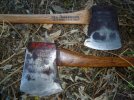- Joined
- Jan 16, 2012
- Messages
- 333

Recently removed about 60 Pinus Radiata from around our house yard. They were around 30 years old. Probably one of the best things we have ever done to reduce the debris of pine needles. They're great for camping on but a nightmare around decks, roofs, gutters, water tanks etc.
What you see in the pic is the left-over off-cuts and reject wood with a small amount of the slash piled up behind. The logs are now on the Port of Napier awaiting export.
The axe is my absolute favourite woodpile axe. A KELLY Dandenong. Her name is 'Big Bertha'. I also have one almost the same named 'Big Bertha's Sister'.
regards...Frank

